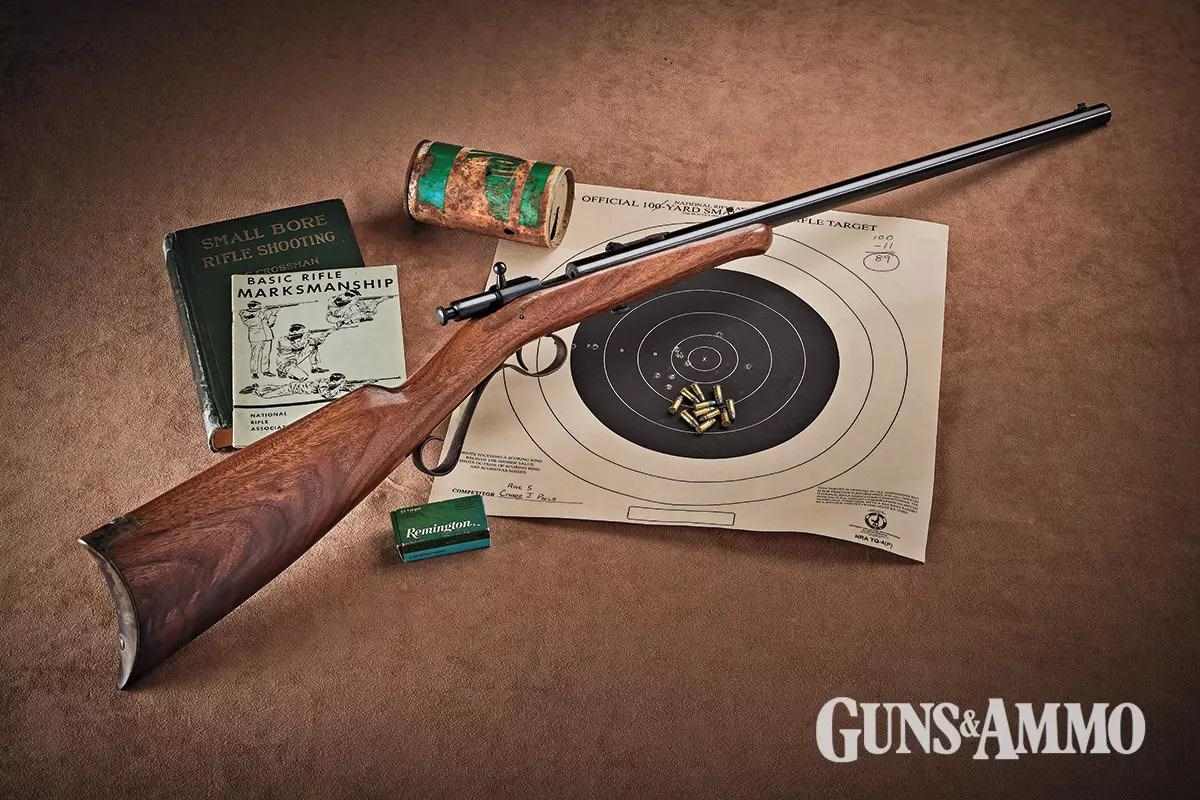Winchester made plenty of inexpensive guns for mass-marketers such as Sears and Montgomery Ward, and to feed the hardware-store trade. Many inspired indifference, and even scorn, such as with the 200-series rimfires made after 1964. But should they? Would you turn up your nose at a rifle designed by John Moses Browning at the very pinnacle of his abilities, even if more than a million were sold at a time when the U.S. population was less than a quarter of its current size?
I thought not.
In 1899, Winchester sought an affordable .22-caliber rifle to market as a plinker and for small-game hunting. Browning filed the patent for the Model 1900 in February 1899, and the design was purchased by Winchester. A few months later, Winchester announced it on a flyleaf attached to the August 1899 catalog. Inexpensive, the rifle was sized for young boys and destined to become an ideal first rifle. Designed as a takedown rifle during a time when the .22-caliber rimfire cartridges were still evolving, it would chamber .22 Short, .22 Long, and later, .22 Extra Long. These were cartridges that a kid could have found in just about any country store in those days. The .22 Extra Long round, which dated to 1880, has been long forgotten except by cartridge collectors. It was longer than the .22 Long Rifle (LR) with a case length of .750 inches to the Long Rifle’s .613 inches, and an overall length of 1.16 inches to the .22 LR’s 1 inch. As some guess, guns chambered for .22 Extra Long can fire .22 LR ammo, but not vice-versa. Since you are a lot more likely to find the gun than the ammo, this is no great problem. Be aware that lots of these guns were extensively fired with corrosive .22 Shorts, which tend to erode a ring inside the chamber, leading to hard extraction.
The barrels of Models 1900, 1902 and 1904 are secured to the stock with a coin-slotted thumbscrew in front of the triggerguard. This allows for easy takedown with a penny. The thumbscrew engages a threaded block dovetailed to the underside of the barrel. That part helps retain the sear spring, which, at its front, engaged a notch in the barrel. At the rear, it presses up on the sear/ extractor.
There is no separate receiver; the barrels were gun-drilled from the rear to accommodate the bolt body. After the pilot hole was bored through the length, rifling would have been cut. Longitudinal notches and slots give passage at the top for the bolt handle, as well as the bottom for the sear/extractor. Cross-milled openings provide access to the loading port.
Advertisement
The trigger is an L-shaped piece pinned into the stock. It engages a recess milled into the sear/extractor and pressed down on that part when pulled, releasing the firing pin.

Cocking is manual, a great feature for a boy’s gun. The bolt does not cock the rifle when it’s cycled. Instead, pull back on the knurled knob at the rear of the bolt to cock. To uncock, keep a firm grip on the cocking knob and pull the trigger to ease it forward under control — but watch your muzzle while doing this! Browning’s approach allows the rifle to be carried loaded, but not cocked, which was especially useful when hunting.
The sear/extractor moves forward and back in its slot during bolt operation. Retracting the bolt pulls it rearward, with the extractor hook removing the spent case. It will eject if operated smartly; if you crank it softly, you’ll need to invert the rifle to dump the empty. When loading, leave the cartridge on the extractor and push the bolt home; don’t load it with the extractor pressed forward because it won’t remove the empty if you do.
Advertisement
If you want to remove the bolt, you’ll need to remove the action from the stock and pull down on the sear/extractor to release the bolt. This also provides access to the breech for cleaning the bore with a cleaning rod from the rear.
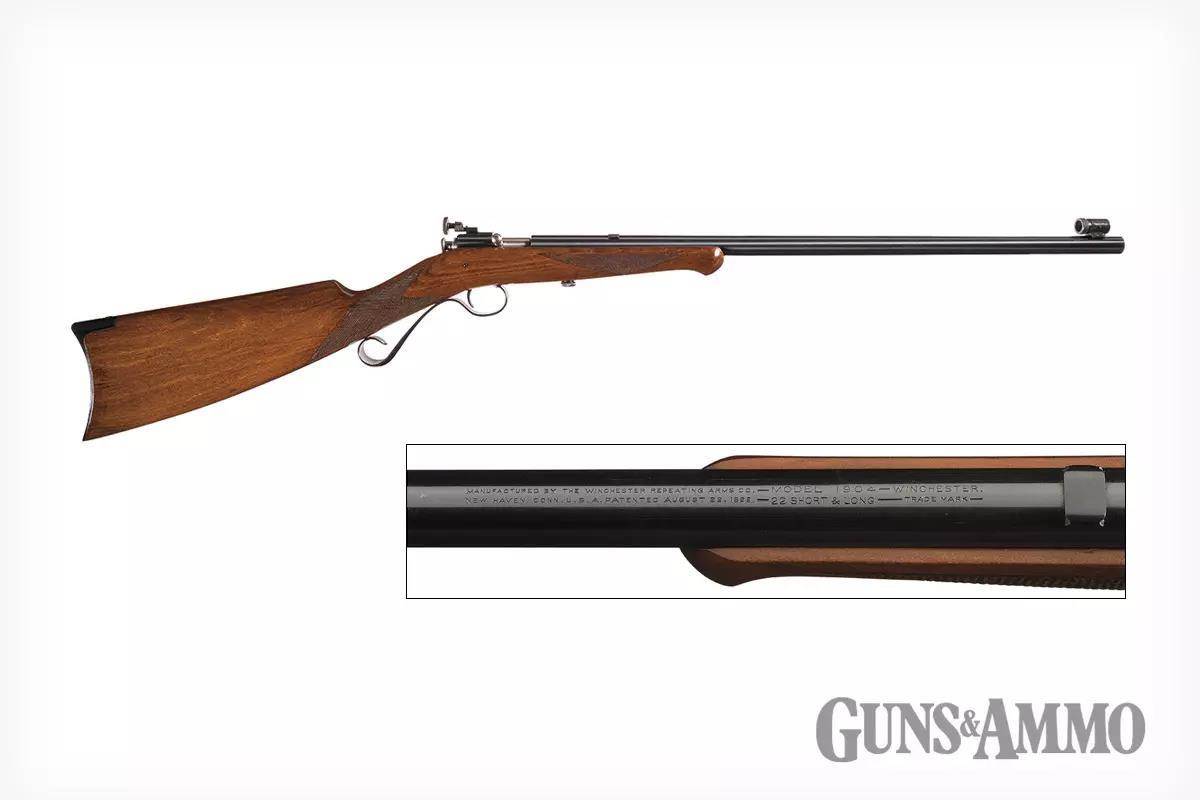
Before 1968, rimfire rifles were not required to have serial numbers, so dating these rimfires is approximate, at best. What’s helpful is identifying the changes between models and considering significant years of development.
Model 1900
If you look closely, you’ll see that the Winchester Model 1900 was awarded its patent on August 19, 1899. The unassuming piece was intended as a boy’s rifle priced at $5, or the equivalent of $183.58 in 2024 dollars. To get to that price point, the Model 1900 was simple in design, sporting an 18-inch barrel with an uncrowned muzzle.
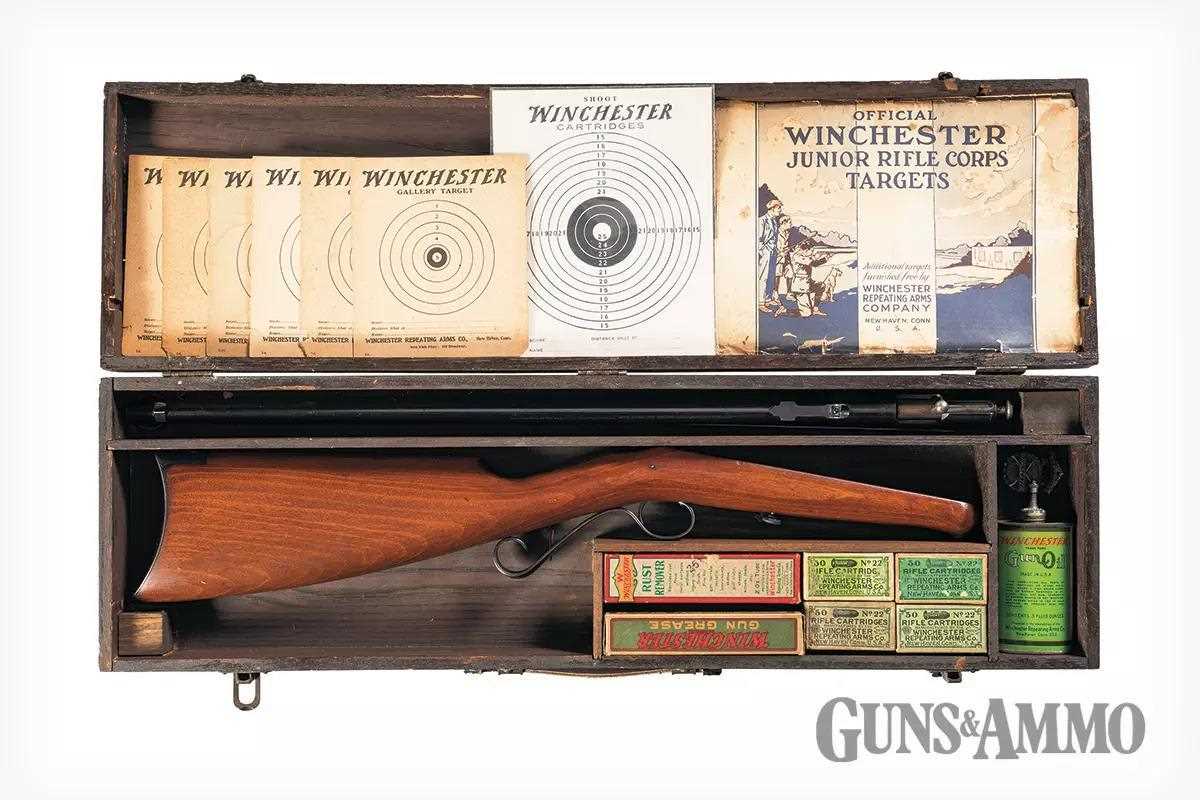
Having a length of pull of 12¾ inches, the straight-gripped stock was made of gumwood, or sometimes a substandard walnut with an oil finish. The original drop at comb measured 1½ inches with 2¾ inches of drop at the heel. The early buttplate was rolled into the shape, with texture. After about 20,000 guns were produced, shotgun-style buttplates were added, many with the Winchester brand later. Once production past 89,000 guns, hard-
rubber buttplates appeared exclusively. The Model 1900 was discontinued in 1902 with about 105,000 produced. It was Winchester’s first action cocked by pulling rearward on the knurled firing-pin head, a Browning invention that has since been employed by most firearms manufacturers. The 1900 was replaced by the Model 1902 single-shot.
Model 1902
First delivered on June 4, 1902, the Model 1902 introduced a shaped triggerguard with the rear extended and curved to support the small of the stock’s function as a pistol grip. The trigger pull was also shortened, and a blued steel buttplate was added. At the muzzle, the barrel was made heavier than on the Model 1900. Early versions of the Model 1902 retained the barrel weight of the Model 1900, with a diameter of .531 inches at the muzzle. After about 70,000 guns were produced, muzzle diameter was increased to .594 inches. Chambering changed to .22 Short, .22 Long and .22 Extra Long, interchangeably, in 1914. It changed again in 1927 to .22 Short, .22 Long, and .22 Long Rifle, and the steel buttplate was changed to a composition buttplate in 1907.

The 1902 was followed by the Winchester Thumb Trigger and Model 1904 rifles. The Thumb Trigger model simplified the gun even more by making the trigger a sliding piece in the top of the grip, operated by the thumb. This allowed the deletion of the finger trigger and the triggerguard. This peculiar system was more popular than you might think, too. Some 75,000 were made from 1902 to 1923.
The Model 1902 was a sales success with 640,300 made by the time it was discontinued in 1931. Notably, a few employees made target pistols using the 1902 action for their own use.
Model 1904
Sensing a demand for a “man-sized” version of its boy’s rifle, Winchester added the Model 1904, which was first delivered on July 5, 1904. This was fitted with a 21-inch barrel in a somewhat larger stock that featured a subtle, but distinctive, Schnabel forend. The rifle was heavier than the Model 1902 by a pound, too. Like the Model 1902, the steel crescent buttplate was changed to a hard rubber buttplate in 1925 and discontinued in 1931. The triggerguard on the Model 1904 was enlarged in proportion to the larger stock, and the 1904 featured a rear sight adjustable for elevation with a small, slotted screw. The price of the Model 1904 was slightly more than the Model 1902 and, therefore, not as successful. Some 302,850 were made before the Depression laid waste to the Winchester line in 1931.
Winchester Junior Rifle Corps
The Winchester Junior Rifle Corps Range Kit No. 1 was first offered in 1920, featuring the Model 1902. The Range Kit No. 2 included the Model 1904. Winchester’s Model 1902 and 1904 were the staple of the Winchester Junior Rifle Corps, a post-World War I effort to promote shooting among the younger set. In keeping with the arrival of women’s suffrage at about the same time, the first member of the Corps was Ruth L. Russell of New Haven, Connecticut.
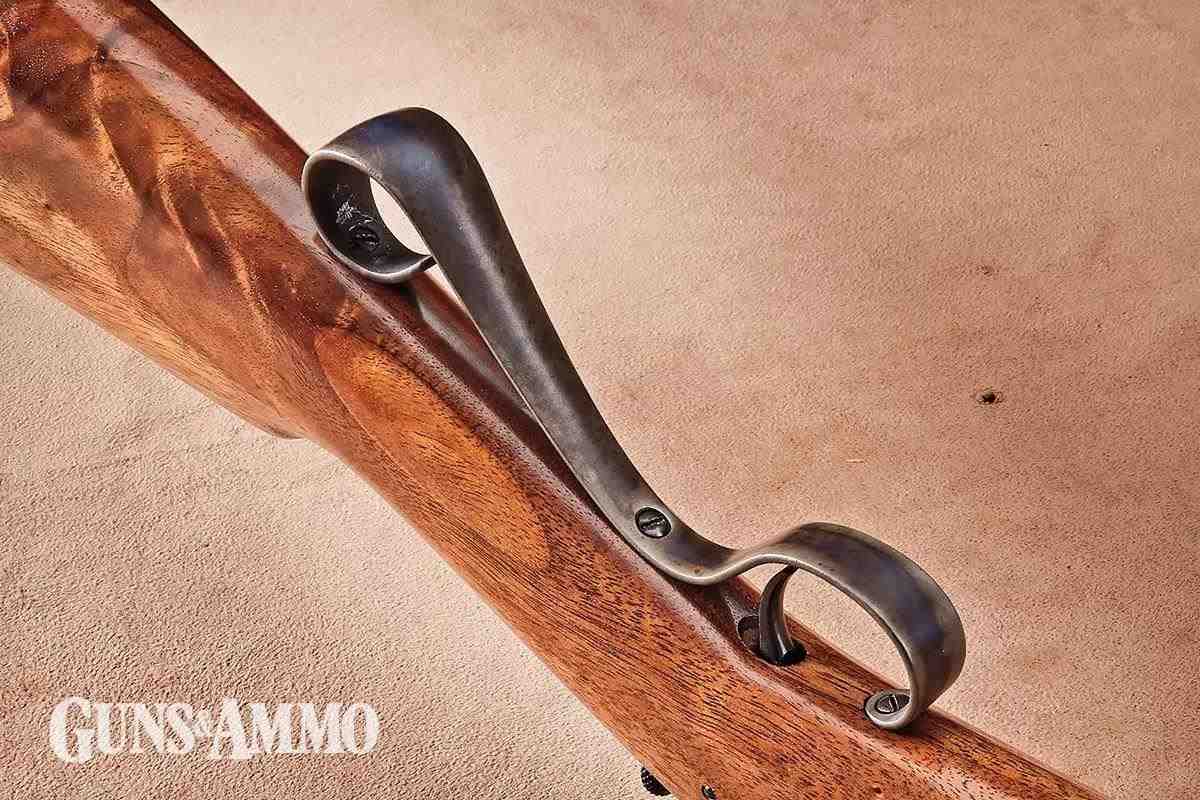
Corps members could buy the cunningly packaged Range Kits that incorporated these smallbore rifles, as well as everything a young shooter would need to get started shooting: Cartridges, cleaning tools, grease, oil, rust remover, targets and belt pouches for notepads and pencils. The one-screw takedown was handy with this configuration because the young rifle owner could quickly disassemble these rifles into two pieces for convenient stowage in the case. One of these sold at a Rock Island Auction on December 1, 2018, for $2,588, sure to have provided the top bidder a fascinating time tunnel back to the past. The Winchester Junior Rifle Corps lasted until 1931, and it was influential in inspiring the NRA Marksmanship Qualification Programs that continue today (http://mqp.nra.org).
Rejuvenation
Dad inherited a Model 1904 from his uncle, and I used it extensively as a boy while riding a bike in the New Mexico desert. I shot at any target of opportunity when the chance offered. Any sort of store, including a lot of gas stations, sold rimfire and shotshell ammo in those days, and I recall a box of .22 Shorts costing about 50 cents. The firing rate of the Model 1904 matched my buying power just right.
In time, I inherited the rifle. Somewhere in those years, the flat sear/extractor spring broke, rendering it non-firing. Checking the usual parts sources showed the supply of replacements was long gone. I suppose I could have had a blacksmith make a replacement, but that project never got off the ground.
I was about to drop it off at a local gun store for use as a parts gun when Guns & Ammo Editor Eric Poole mentioned his ’04 had a flat spring but was missing other parts. Using it to ’coon hunt with as a kid, Poole’s had a stock that had been sawed off to fit a 10-year-old’s frame. It didn’t take a genius to know one working rifle beats two parts queens, so I handed mine over to get his going. Knowing that it would never be a collector’s dream, Poole packed them off to Houston gunsmith Bruce Lohman.
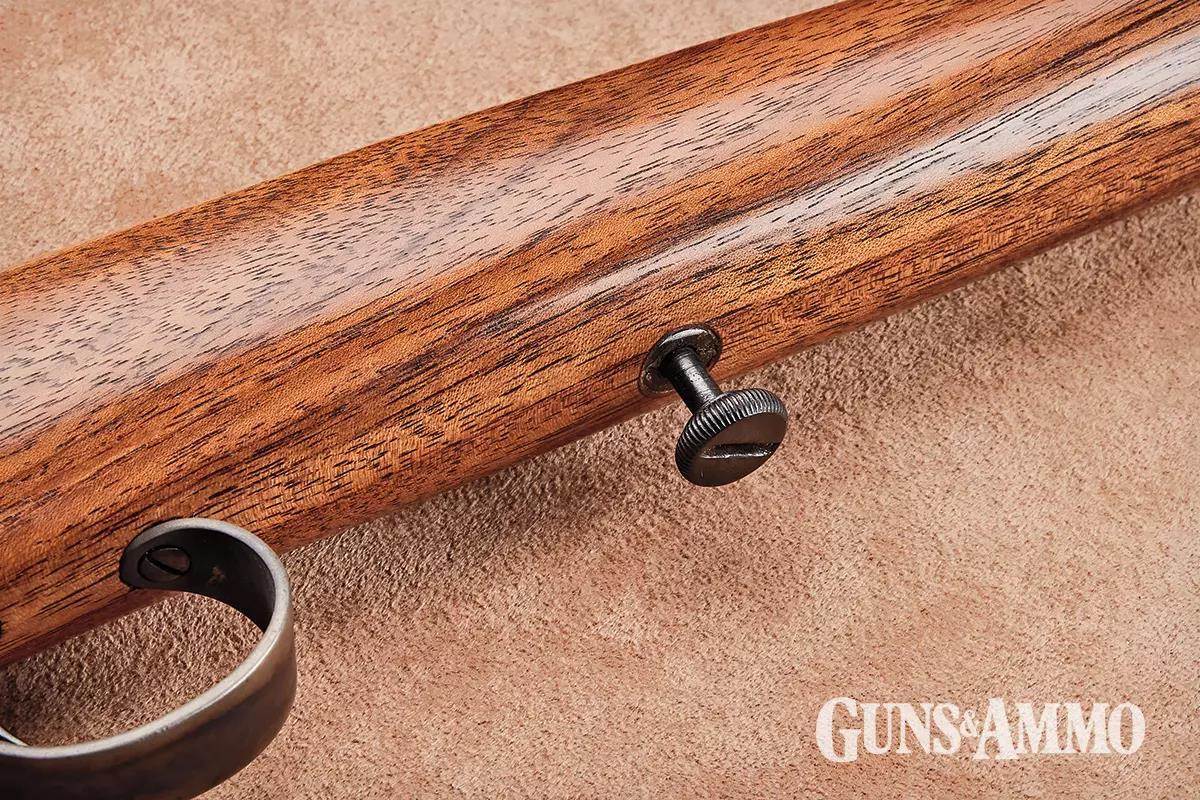
Lohman’s shop provides a full range of services for all sorts of firearms. With some patience, Lohman charcoal-blued the barreled action, enhanced the crescent steel buttplate and triggerguard with color-case hardening, and skillfully shaped a Schnabel-forend stock out of a figured piece of walnut. The result is probably the fanciest Winchester Model 1904 in captivity.
There is no great need to benchrest a gun like this; it’s intended for the field shooting of small game, target shooting, and plinking. Sights are an open rear and a .065-inch bead front. You wouldn’t have wanted these at Camp Perry, but they are just fine for a youngster in pursuit of small game. I did give it a function test, though, with both .22 LR ammo and CB caps. Both were digested easily when the proper loading procedure was applied.

The trigger is still no great shakes by today’s standards, but it’s perfectly usable for pounding a steel spinner target at 25 yards offhand. I missed only when I got cute and tried to hit the very top edge of the target to spin it hard. The rifle shot about an inch to the right at that range, a condition that would be corrected by driving the rear sight a bit to the left or the front sight to the right.
I find that shooters under the age of 40, or so, are often puzzled by how to use a rifle with a crescent buttplate. They’ve spent their shooting careers firing AR-15s and other modern sporting rifles with the low-elbow stance that’s popular today. That doesn’t work so well with the classics of a century back. These were intended for the high-elbowed stance needed for a firm cheekweld, especially with stocks having a substantial drop. Hold the Model 1904 in this manner and it’s a breeze to shoot.
A box of 100 .22 LR cartridges and a handful of CB caps kept three of us shooting busily for about an hour on a warm spring day. Shooting this single-shot brought back memories of a time before I had ever heard 30-round mag dumps pollute the typical range experience. The Model 1904 raises the question: What’s the rush?

Winchester Model 1904
- Type: Bolt action, Single Shot
- Cartridge: .22 Short, .22 Long Rifle, .22 Extra Long
- Barrel: 21in.; round profile
- Overall Length: 36 in.
- Weight: 4 lbs.
- Stock: Gumwood, straight grip
- Finish: Blue (Steel)
- Sights: Bead (front), V-notch (rear)
- Safety: None
- Trigger: 6 lbs.
- Discontinued: 1946
- Manufacturer: Winchester
Read the full article here


